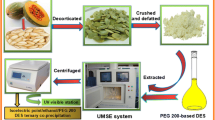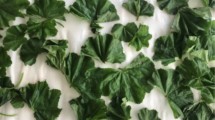Abstract
A novel method for protein extraction from sweet almonds with aqueous polyethylene glycol (PEG) as solvent and recovery from the extraction solution was developed. The extraction yields of different solvents, such as sodium hydroxide, sodium chloride, PEG 200, PEG 400, and PEG 600 aqueous solutions, were investigated and PEG 200 showed the highest extraction efficiency. The PEG-based microwave-assisted extraction (MAE) parameters were then optimized using response surface methodology. Under optimum condition, PEG 200 concentration of 25 % (w/w), liquid to solid ratio of 22 mL g−1, microwave power of 120 W, extraction temperature of 45 °C, and extraction time of 4 min, the average extraction yield was 93.75 ± 3.15 %. Subsequently, the almond protein was recovered from the extraction solution containing PEG with an isoelectric point-ethanol synergy precipitation protocol. The combined technique integrated the speed of isoelectric point precipitation with the completeness of alcohol precipitation. The recovery of almond protein was 98.81 % with a time of 3–5 min. The proposed PEG-based MAE and synergy precipitation protocol provide a rapid and effective method for almond protein extraction and recovery and have the potential to be used for other plant proteins.


Similar content being viewed by others
References
Barbosa H, Slater NKH, Marcos JC (2009) Protein quantification in the presence of poly(ethylene glycol) and dextran using the Bradford method. Anal Biochem 395:108–110
Barizao EO, Boeing JS, Martins AC, Visentainer JV, Almeida VC (2015) Application of response surface methodology for the optimization of ultrasound-assisted extraction of pomegranate (Punica granatum L.) seed oil. Food Anal Methods 8:2392–2400
Calixto FS, Bauza M, Toda FM, Argamenteria A (1981) Amino acids, sugars, and inorganic elements in the sweet almond (Prunus amygdalus). J Agric Food Chem 29:509–511
Capriotti AL, Cavaliere C, Piovesana S, Stampachiacchiere S, Ventura S, Chiozzi RZ, Laganà A (2015) Characterization of quinoa seed proteome combining different protein precipitation techniques: improvement of knowledge of nonmodel plant proteomics. J Sep Sci 38:1017–1025
Chiesa S, Gnansounou E (2011) Protein extraction from biomass in bioethanol refinery—possible dietary applications: use as animal feed and potential extension to human consumption. Bioresour Technol 102:427–436
Ding XL, Zhang H, Chen HY, Wang L, Qian HF, Qi XG (2015) Extraction, purification and identification of antifreeze proteins from cold acclimated malting barley (Hordeum vulgare L). Food Chem 175:74–81
Dourado F, Barros A, Mota M, Coimbra MA, Gama FM (2004) Anatomy and cell wall polysaccharides of almond (Prunus dulcis D A Webb) seeds. J Agric Food Chem 52:1364–1370
Femenia A, Rosselló C, Mulet A, Cañellas J (1995) Chemical composition of bitter and sweet apricot kernels. J Agric Food Chem 43:356–361
Griffin ST, Dilip M, Spear SK, Huddleston JG, Rogers RD (2006) The opposite effect of temperature on polyethylene glycol-based aqueous biphasic systems versus aqueous biphasic extraction chromatographic resins. J Chromatogr B 844:23–31
Habibi H, Mohammadi A, Hoseini H, Mohammadi M, Azadniya E (2013) Headspace liquid-phase microextraction followed by gas chromatography–mass spectrometry for determination of furanic compounds in baby foods and method optimization using response surface methodology. Food Anal Methods 6:1056–1064
Hadi BJ, Sanagi MM, Aboul-Enein HY, Ibrahim WAW, Jamil S, Muazu MA (2015) Microwave-assisted extraction of methyl β-cyclodextrin-complexed curcumin from turmeric rhizome oleoresin. Food Anal Methods 8:2447–2456
Kim YJ, Lee HM, Wang Y, Wu J, Kim SG, Kang KY, Park KH, Kim YC, Choi IS, Agrawal GK, Rakwal R, Kim ST (2013) Depletion of abundant plant RuBisCO protein using the protamine sulfate precipitation method. Proteomics 13:2176–2179
Lee AY, Kim HS, Choi G, Moon BC, Chun JM, Kim HK (2014) Optimization of ultrasonic-assisted extraction of active compounds from the fruit of star anise by using response surface methodology. Food Anal Methods 7:1661–1670
Liu R-L, Zhang J, Mou Z-L, Hao S-L, Zhang Z-Q (2012) Microwave-assisted one-step extraction-derivatization for rapid analysis of fatty acids profile in herbal medicine by gas chromatography-mass spectrometry. Analyst 137:5135–5143
Liu R-L, Song S-H, Wu M, He T, Zhang Z-Q (2013) Rapid analysis of fatty acid profiles in raw nuts and seeds by microwave–ultrasonic synergistic in situ extraction–derivatisation and gas chromatography–mass spectrometry. Food Chem 141:4269–4277
Ma X, Zhou X-Y, Qiang Q-Q, Zhang Z-Q (2014) Ultrasound-assisted extraction and preliminary purification of proanthocyanidins and chlorogenic acid from almond (Prunus dulcis) skin. J Sep Sci 37:1834–1841
Papadakis E-N, Kyrgidou A, Vryzas Z, Papadopoulou-Mourkidou E (2014) Development of a microwave-assisted extraction method for the determination of organochlorine pesticides in mussel tissue. Food Anal Methods 7:1271–1277
Perumalsamy M, Batcha MI (2011) Synergistic extraction of bovine serum albumin using polyethylene glycol based aqueous biphasic system. Process Biochem 46:494–497
Purkayastha MD, Dutta G, Barthakur A, Mahanta CL (2015) Tackling correlated responses during process optimisation of rape seed meal protein extraction. Food Chem 170:62–73
Qu W-X, Mou Z-L, Cui H-Y, Zhang Z-Q (2011) Analysis of fatty acids in A. szechenyianum Gay by microwave-assisted extraction and gas chromatography-mass spectrometry. Phytochem Anal 22:199–204
Ramezani H, Hosseini H, Kamankesh M, Ghasemzadeh-Mohammadi V, Mohammadi A (2015) Rapid determination of nitrosamines in sausage and salami using microwave-assisted extraction and dispersive liquid-liquid microextraction followed by gas chromatography–mass spectrometry. Eur Food Res Technol 240:441–450
Salgado PR, Drago SR, Ortiz SEM, Petruccelli S, Andrich O, González RJ, Mauri AN (2012) Production and characterization of sunflower (Helianthus annuus L) protein-enriched products obtained at pilot plant scale. LWT-Food Sci Technol 45:65–72
Sarfarazi M, Jafari SM, Rajabzadeh G (2015) Extraction optimization of saffron nutraceuticals through response surface methodology. Food Anal Methods 8:2273–2285
Teh S-S, Niven BE, Bekhit AA, Carne A, Birch J (2015) Optimization of polyphenol extraction and antioxidant activities of extracts from defatted flax seed cake (Linum usitatissimum L.) using microwave-assisted and pulsed electric field (PEF) technologies with response surface methodology. Food Sci Biotechnol 24:1649–1659
Vergara-Barberan M, Lerma-García MJ, Herrero-Martínez JM, Simó-Alfonso EF (2015) Use of an enzyme-assisted method to improve protein extraction from olive leaves. Food Chem 169:28–33
Wang C, Wang Q, Tian J (2011) ACE-inhibitory and antihypertensive properties of apricot almond meal hydrolysate-advise. Eur Food Res Technol 232:549–556
Wu X-H, Liu D, Ceng Y-X, Huang Y, Su W (2008) Study on extraction technology of plant protein from fruit pomace of Gardenia jasminoides Ellis. Food Sci 29(12):336–338
Zhao XY, Chen FS, Chen JQ, Gai GS, Xue WT, Li LT (2008) Effects of AOT reverse micelle on properties of soy globulins. Food Chem 111:599–605
Zhou T, **ao XH, Li GK, Cai ZW (2011) Study of polyethylene glycol as a green solvent in the microwave-assisted extraction of flavone and coumarin compounds from medicinal plants. J Chromatogr A 1218:3608–3615
Zhou X-Y, Liu R-L, Ma X, Zhang Z-Q (2014) Polyethylene glycol as a novel solvent for extraction of crude polysaccharides from pericarpium granati. Carbohyd Polym 101:886–889
Zhu Z, Qiu N, Yi J (2010) Production and characterization of angiotensin converting enzyme (ACE) inhibitory peptides from apricot (Prunus armeniaca L.) kernel protein hydrolysate. Eur Food Res Technol 231:13–19
Author information
Authors and Affiliations
Corresponding author
Ethics declarations
The manuscript has not been published previously (partly or in full). The manuscript has not been submitted to more than one journal for simultaneous consideration.
Consent to submit has been received explicitly from all co-authors, as well as from the institute/organization where the work has been carried out, before the work is submitted.
Authors whose names appear on the submission have contributed sufficiently to the scientific work and therefore share collective responsibility and accountability for the results.
Funding
The project was supported by National Natural Science Foundation of China (No. 21275098).
Conflict of Interest
**an-Li Ge declares that he has no conflict of interest. Ting Shi declares that she has no conflict of interest. Huan Wang declares that she has no conflict of interest. **g Zhang declares that she has no conflict of interest. Zhi-Qi Zhang declares that he has no conflict of interest.
Ethical Approval
This article does not contain any studies with human participants or animals performed by any of the authors.
Informed Consent
Informed consent is not applicable.
Rights and permissions
About this article
Cite this article
Ge, XL., Shi, T., Wang, H. et al. Development of an Aqueous Polyethylene Glycol-Based Extraction and Recovery Method for Almond (Prunus armeniaca L.) Protein. Food Anal. Methods 9, 3319–3326 (2016). https://doi.org/10.1007/s12161-016-0525-3
Received:
Accepted:
Published:
Issue Date:
DOI: https://doi.org/10.1007/s12161-016-0525-3




